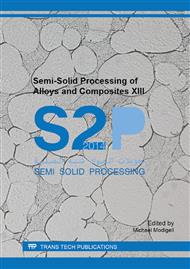p.361
p.366
p.374
p.381
p.389
p.397
p.405
p.412
p.418
New Semisolid Casting of an Al-25Wt.% Mg2Si Composite Using Vibrating Cooling Slope
Abstract:
Al-Mg2Si composites have gained considerable attention because of their attractive properties such as low density, improved wear resistance and good castability. However, when in-situ routes are used for processing of these composites, the formation of coarse Mg2Si particles with sharp cornersis inevitable and is detrimental for the composite properties. This problem is intensified when a hypereutectic composition such as Al-25wt.% Mg2Si alloy is processed. In the present study, an innovative semisolid technique termed as the Vibrating Cooling Slope (VCS) has been applied to produce a sample of in-situ Al-25wt.% Mg2Si composite.This technique combines the conventional cooling slope and vibration casting methods into an integrated one for producing fine and globular structures in the as-cast condition. An inclined plate was prepared from a 10mm thickness copper plate and was coated by boron nitride. This platecould vibrate mechanically in the vertical direction at a predetermined frequency by the aid of four springs and an electric motor. The molten Al-16.5wt.%Mg-9.4%Sialloy with 100o C superheat was poured on the surface of this cooling slope (set at 45° inclined angle)while it was vibrating at the frequency of 40 Hzandamplitude of 400 μm.The semisolid alloy travelled the length of 40 cm on the slope before being poured into a steel mold (60 mm internal diameter and 35 mm in height). Also for the purpose of comparison, gravity casting (GC) and conventionally still cooling slope casting (CS)were carried outboth using the same mold and with the same superheat.The samples were sectioned, polished and subjected to metallographicstudies,porosity and hardness measurements. It was concluded that CS and VCS techniques resulted in a decrease in the size of Mg2Si particles by about 50%and 70% respectively when compared with the gravity casting. However, the increased shape factor of Mg2Si particles in the VCS and CS processed samples was insignificant as compared with GC. Although in comparison with GC, the VCS processed sample showed a higher porosity level, it exhibited a higher hardness value. These results were attributed to the finer and modified microstructure obtained via this newly developed technique.
Info:
Periodical:
Pages:
389-396
Citation:
Online since:
September 2014
Authors:
Keywords:
Price:
Сopyright:
© 2015 Trans Tech Publications Ltd. All Rights Reserved
Share:
Citation:


